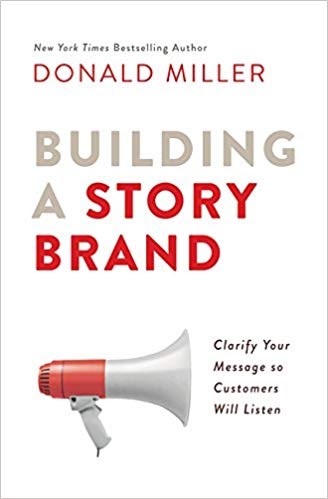What Is StoryBrand?
What is StoryBrand?
Introduce the age-old tradition of storytelling into the contemporary world of personal & business brand messaging and you have a powerful and compelling methodology how to effectively communicate with fellow humans.
What is StoryBrand?
Most of us grew up listening to stories. Even now when someone starts a conversation with “Let me tell you….” our brains magically tune in and we listen. We listen because stories are easy to follow, easy to visualise and easy to understand.
“…we have a world where personal and business branding must shout louder.”
The reason for StoryBrand’s incredible growth is timing.
Never before has so much content been curated and distributed across so many channels as we see today. It’s search engines and digital devices that have become the game changers , in a world hungry to consume content
Weak and confusing brand messaging fail to be heard,
Powerful search engines encourage us to create fresh, relevant and unique content. This means the need to shout louder magnifies, volumes increase resulting in weak and confusing messages.
Weak and confusing brand messaging fail to be heard, struggle to attract new customers, leading to stagnation and decreasing sales growth, resigning these business’ to the sidelines.
“The StoryBrand philosophy was created so that individuals and businesses stop confusing their customers and stop wasting their marketing budgets.”
People are naturally drawn to businesses which:
- Clearly tell what they do
- Explain how they help their customers
- Tell their customers why they should buy from them.
How do you avoid confusing and complex messages?
Created by Donald Miller, StoryBrand is a marketing framework with a philosophy comprising 7 key elements designed to help businesses understand their customer’s stories and clearly communicate how they help their customers.
“I’ve seen the success of StoryBrand time and time again.”
The StoryBrand philosophy was created so that individuals and businesses stop confusing their customers and stop wasting their marketing budgets.
As a StoryBrand Certified Guide trained to deliver effective brand messaging, I’ve seen the success of StoryBrand time and time again. So many times I’ve seen the lightbulb switch on, when business owners recognise when theory becomes reality.
Here’s how StoryBrand’s 7-Part Framework works:
Let’s break this down:
The StoryBrand 7-Part Framework
If you want to ‘StoryBrand’ you or your business let’s start at the top with the StoryBrand “BrandScript”.
When StoryBrand’s founder Don Miller questioned why his marketing wasn’t working, he took time to understand what made a clear brand message.
This are the 7 points that must clarify every marketing message:
- A character
- With a problem
- Meets a guide
- Who gives them a plan
- That calls them to action
- That results in success
- Or failure
A Character
“The hero in the story is your main client or customer.”
When we listened to those stories, we remember that each story had a hero. Quite simply with StoryBrand, our hero is the character. For you and your business, the hero in the story is your main client or customer.
Quite often our hero needs something, but they’re not sure what they need. They’re not sure how to get it. They’re not sure where to go to get it. They ponder. They procrastinate. Our hero might need many things but when we distill this down our hero is usually searching for one thing.
Tom Hanks played Captain John Miller taking his troop of soldiers behind enemy lines to search for Private James Ryan, whose three brothers were killed in combat. Harry Potter was our hero pitting his magical skills against Lord Voldemort. Russell Crowe as Maximus Decimus Meridius was our hero seeking revenge on the Emperor Commodus. Jason Bourne was searching for his true identity.
With a Problem
Within the first 10-mins of any film we need to understand what the hero’s problem is and how the problem is making our hero feel. As well as how the problem is making our hero feel, there may also be a philosophical issue that needs solving.
Good .v. Evil.
Right .v. Wrong.
Truth .v. Lies.
Meets a Guide
“Be The Guide.”
The hero of our story always needs a guide to give our hero direction. In the original Rocky it was Mick. In the Shawshank Redemption, Red played by Morgan Freeman helped guide Andy Dufresne (Tim Robbins) through his back-to-back life sentences.
The guide is the person who appears showing the hero what to do to survive, thrive and win the day.
Here’s the paradigm shift for business owners. Your customer is the hero… you are the guide.
Here’s the paradigm shift for personal branding. Your audience is the hero…you are the guide.
Don’t be the hero. Present yourself as the guide. Be the guide.
Who Gives Them a Plan
The guide gives the hero a plan. Direction. A sign-post. It can be wisdom, knowledge or experience [think Obi Wan Kenobi in Star Wars]. It can be something quite simple and easy for our hero to act upon.
That Calls Them to Action
If you don’t call your customers to action, they won’t take action. In an eCommerce business this is a clear call to action to ‘Search” or “Buy Now”. If you’re trading a new service you may want your online users to “Schedule A Call”. Simply guide your customers to what you’d like them to do. Yoda calls out to Luke to “Use The Force”. You as the guide have to call your customers to action.
Give your hero an easy 3-step plan, but no more than 5!
Tell your hero how easy it is to solve their problem and how they work with you.
That Results in Success
Here’s the aspirational step. Remind your hero what success looks like and what their life could be like if they do this. In your business, how will your customers feel when they’ve worked with you?
Creating your StoryBrand BrandScript should include all the ways that your customer’s life can be transformed. Brainstorm and get everything down. Feel the aspiration. Share images that showcase positivity and success.
Or Failure…
Your hero has a problem which they can’t fix without the guide’s help. This focus highlights what might happen if they don’t do business with us. Failure to act won’t make the situation go away. Without you as the guide the hero will simply procrastinate, avoid taking action, resulting in failure. .
Having spoken with our customers and knowing what they need, creating the BrandScript gives us a more informed understanding based on fact and research what makes customers buy from you.
If we don’t to discuss our customers failure, they will stop listening to us.
Why Will StoryBrand Work For My Business?
Some business leaders are confident with their brand message and don’t feel the need to revisit the framework.
As a guide I ask them:
- Having spent money attracting people to your website, how many simply bounce to a competitor?
- What % of online users buy on your website. Is it double-figures yet?
- How many of your online users are confused what you do?
- How many of those same online users are not convinced why they should buy from you and buy from a competitor?
- How many sales pitches do you convert?
The answer should be: “I can always improve and succeed more.”
If you deal with customers with a human brain, StoryBrand will work for you. StoryBrand will bring clarity to accelerate business growth.
Here is a list of B2B and B2C categories where StoryBrand is perfect:
| Financial Advisors | FTSE 500 Companies | Retail |
| Tech Companies | Consultants | Small Businesses |
| Property Agents | Start-ups | Non-Profits |
| Service-Based Companies | Restaurants | Solopreneurs |
| Manufacturers | Medical professionals | Government agencies |
| Banks | Sports Teams | Medical Products |
Is There Proof StoryBrand Works?
As part of his PhD, Dr. J.J. Peterson, on the senior leadership team at StoryBrand studied this question.
He started with 3 hypotheses:
- StoryBrand improves profitability
- StoryBrand improves employee morale and confidence
- With the need create collateral, StoryBrand saves you time & money.
Dr. Petersen learned that the only factor that directly affected these three areas was the level of implementation in all areas of marketing. The companies who implemented StoryBrand in all areas of marketing saw improvement in all three areas.
The only thing that mattered was how much they actually did StoryBrand.
And as an example of success closer to home, StoryBrand has grown from zero to $15m turnover in 5-years.

In conclusion to What is StoryBrand?
I hope this post gives you an insight into StoryBrand.







